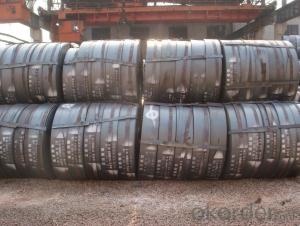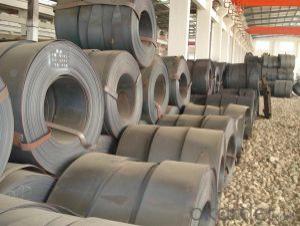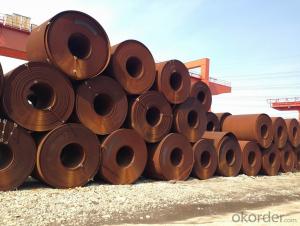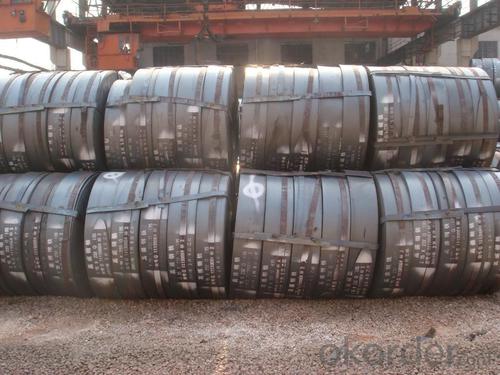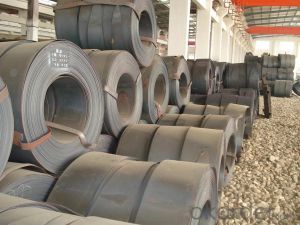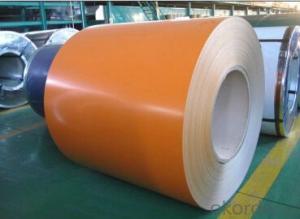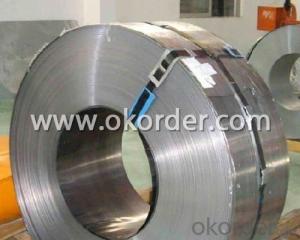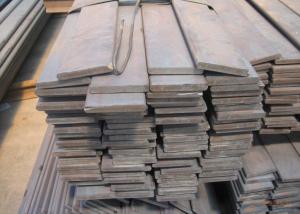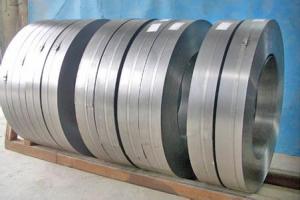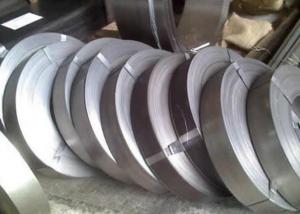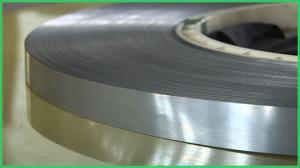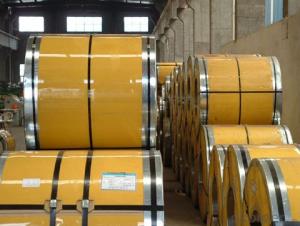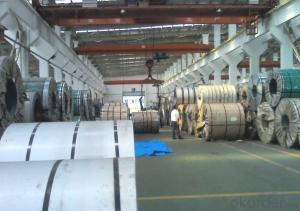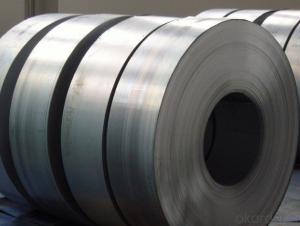Hot Rolled Steel Strip for Spring in Car
- Loading Port:
- Qingdao
- Payment Terms:
- TT OR LC
- Min Order Qty:
- 500 m.t.
- Supply Capability:
- 10000 m.t./month
OKorder Service Pledge
OKorder Financial Service
You Might Also Like
Specification
1. Product Description
The Billets as raw materials, through furnace heating, high-pressure water to reduce the phosphorus, then entering the roughing mill, cutting head, end, and then put into the finishing mill, cutting the edge, after the times of straightening, leveling and other finishing line treatment, and then cutting board or coil becomes the hot rolled steel sheet and hot rolled steel coil.
2. Main Features
Characteristics of hot rolled steel hot-rolled steel is a high temperature heating and rolled steel, hot rolled product has high strength, good toughness, easy to processing molding and good weldability and other excellent properties, which are widely used in ship, automobile, Bridges, buildings, machinery, pressure vessels and other manufacturing industries.
3. Excellent Product Image
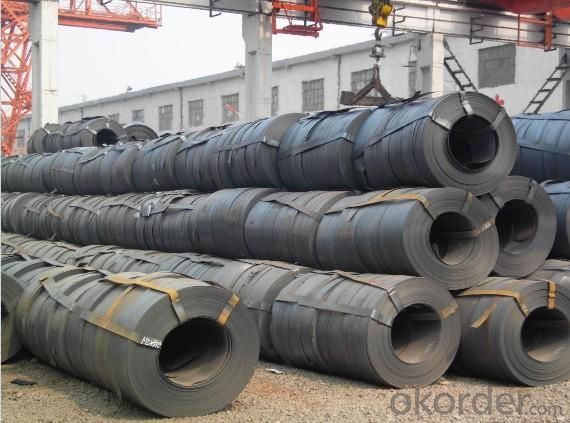
4. Application
Our hot-rolled steel coil and sheet are applied to a wide range of uses such as automobile, electrical appliance, machinery manufacturing, container manufacturing, shipbuilding, bridge, pipeline, and receive high acclaim from our customers for its excellent quality.
5. FAQ
1.Q: Do you have attended any exhibition?
A: We almost go to Canton Fair and Overseas Exhibitions every year.
2. Q: How to guarantee the quality of the products?
A: We have established the international advanced quality management system,every link from raw material to final product we have strict quality test;We resolutely put an end to unqualified products flowing into the market. At the same time, we will provide necessary follow-up service assurance.
3. Q: How long can we receive the product after purchase?
A: Usually within thirty working days after receiving buyer’s advance payment or LC. We will arrange the factory manufacturing as soon as possible. The cargo readiness usually takes 15-25 days, but the shipment will depend on the vessel situation.
Why choose us?
Pre-sale Service
1. Sample can be offered with sample charge and courier fee by buyer's side.
2. We have full stock,and can deliver within short time.Many styles for your choices.
3. OEM and ODM order are accepted, Any kind of logo printing or design are available.
4. Good Quality + Factory Price + Quick Response + Reliable Service, is what we are trying best to offer you
5. All of our products are produce by our professional workman and we have our high-work-effect foreign trust-worthy sales team.
6. We have 18 years' experience of design, manufacture and sell lingerie, we cherish every order from our honor.
After you choose
1. Count the most efficient shipping cost and make invoice to you at once.
2. Check quality again, then send out to you at 1-2 working day after your payment.
3. Email you the tracking no, and help to chase the parcels until it arrive you.
- Q: How are steel strips used in the production of automotive components?
- Steel strips are widely used in the production of automotive components due to their strength, durability, and versatility. These strips are typically made from high-quality steel alloy and come in various thicknesses and widths to suit different manufacturing requirements. One common application of steel strips in automotive production is for the fabrication of body panels. These strips are often stamped or pressed into shape using specialized machinery to create components such as doors, hoods, roofs, and fenders. The high strength of steel allows for thinner panels, reducing the overall weight of the vehicle while maintaining structural integrity and safety. Steel strips are also commonly used in the production of suspension and chassis components. These strips can be cut, bent, and welded to form various parts such as brackets, brackets, and reinforcements. The strong and rigid nature of steel ensures that these components can withstand the heavy loads and stresses experienced by vehicles during operation. Furthermore, steel strips are used in the manufacturing of engine and transmission components. These strips can be formed into intricate shapes and then heat-treated or machined to achieve the desired strength and precision. Examples of such components include gears, shafts, valves, and crankshafts. The high wear resistance and heat resistance of steel make it an ideal material for these critical components that are subjected to extreme conditions. In addition to their mechanical properties, steel strips are also used for their corrosion resistance. Automotive components made from steel strips are often coated with protective layers such as zinc or paint to prevent rusting and ensure longevity. In summary, steel strips play a vital role in the production of automotive components due to their strength, durability, versatility, and corrosion resistance. They are used in various applications ranging from body panels to suspension and engine components, contributing to the overall performance, safety, and longevity of vehicles.
- Q: What are the different cleaning methods for steel strips?
- There are several different cleaning methods for steel strips, including mechanical cleaning, chemical cleaning, and electrochemical cleaning. Mechanical cleaning involves using abrasive materials or brushes to physically remove dirt, debris, or scale from the surface of the steel strip. Chemical cleaning involves using various cleaning solutions or solvents to dissolve or loosen contaminants on the strip. Electrochemical cleaning utilizes an electric current to remove oxidation or other surface contaminants through the process of electrolysis. The choice of cleaning method depends on the specific requirements and condition of the steel strip.
- Q: How are steel strips cleaned and degreased?
- Different methods can be used to clean and degrease steel strips, depending on specific requirements and conditions. One common approach involves the use of a chemical cleaning solution designed to eliminate grease and oil from the steel's surface. This solution is typically applied to the strips and left for a certain period to break down the grease and oil. Afterward, the steel strips are usually rinsed with either water or a cleaning agent to eliminate any remaining residues. In some instances, a high-pressure water jet may be employed to enhance the cleaning process and ensure the removal of all contaminants. Another technique for cleaning and degreasing steel strips involves mechanical means, such as the use of brushes or abrasive materials to physically scrub away the grease and oil. This method is often preferred for more substantial build-ups or when the steel strips have a rougher surface that requires a more aggressive cleaning approach. Furthermore, advanced techniques like ultrasonic cleaning can be utilized to eliminate grease and oil from steel strips. This involves the usage of high-frequency sound waves to generate tiny bubbles in a cleaning solution, which then implode and create intense agitation to dislodge and remove contaminants from the steel's surface. Overall, the choice of cleaning and degreasing method for steel strips depends on factors such as the level of contamination, the type of grease or oil present, and the desired cleanliness requirements. It is essential to carefully select the appropriate cleaning method to ensure thorough cleaning of the steel strips, making them ready for further processing or use.
- Q: What are the current trends in steel strip manufacturing?
- The steel strip manufacturing industry is being shaped by various current trends, which are driving innovation. One notable trend is the increasing demand for customized and high-quality steel strips. Thanks to technological advancements, manufacturers can now produce steel strips with precise dimensions, improved surface finishes, and specific mechanical properties to cater to the unique requirements of different industries. As a result, specialized steel strip products have been developed for sectors such as automotive, construction, and aerospace. Another trend is the adoption of advanced manufacturing processes and automation. Manufacturers are investing in cutting-edge machinery and automation systems to boost productivity, minimize errors, and enhance overall efficiency. Processes like continuous casting, hot rolling, cold rolling, and annealing are being automated to ensure consistent and high-performance steel strip production. Sustainability is also a crucial trend in steel strip manufacturing. Companies are focused on reducing their environmental impact by implementing energy-efficient practices, recycling scrap materials, and optimizing resource consumption. Furthermore, there is a growing interest in developing eco-friendly coatings and surface treatments that provide corrosion protection while minimizing harmful emissions. In addition, the steel strip manufacturing sector is being revolutionized by digitalization and data-driven solutions. The integration of Internet of Things (IoT) devices and sensors allows real-time monitoring of production processes, enabling manufacturers to collect and analyze data for quality control, predictive maintenance, and optimization of production parameters. This digital transformation is resulting in improved productivity, reduced downtime, and enhanced product quality. Lastly, research and development play a significant role in steel strip manufacturing. Manufacturers are investing in research to explore new materials, improve production techniques, and develop innovative products. This includes the utilization of advanced alloys, coatings, and surface treatments to enhance the performance and lifespan of steel strips. Overall, the current trends in steel strip manufacturing revolve around customization, automation, sustainability, digitalization, and research and development. These trends are propelling the industry towards higher efficiency, improved quality, and the development of innovative steel strip products to meet the evolving needs of various industries.
- Q: Are steel strips suitable for making fasteners?
- Indeed, steel strips prove to be a suitable option for fabricating fasteners. Renowned for its robustness and longevity, steel emerges as an optimal material for the production of fasteners. By effortlessly molding steel strips into various configurations and dimensions, it becomes possible to manufacture a diverse range of fasteners, including screws, bolts, nuts, and clips. Moreover, steel strips exhibit exceptional resistance to corrosion, ensuring that the fasteners remain fully intact and operational even in the face of harsh conditions. Furthermore, the hardness of steel guarantees dependable tensile strength, thus enabling fasteners to securely bind objects together. Ultimately, steel strips offer a dependable and versatile alternative for the creation of fasteners.
- Q: How do steel strips contribute to thermal conductivity in various applications?
- Steel strips contribute to thermal conductivity in various applications by providing a high thermal conductivity pathway for heat transfer. Due to their metallic nature and dense structure, steel strips efficiently conduct heat from one point to another, making them suitable for applications such as heat exchangers, cooling systems, and thermal management in electronic devices. The high thermal conductivity of steel strips allows for effective heat dissipation, enhancing the overall efficiency and performance of these applications.
- Q: What are the typical industries that use steel strips?
- The typical industries that use steel strips include automotive, construction, manufacturing, packaging, and energy sectors.
- Q: What are the factors that affect the vibration damping properties of steel strips?
- There are several factors that can affect the vibration damping properties of steel strips. These factors include the composition and microstructure of the steel, the thickness and surface finish of the strip, the presence of any coatings or treatments, and the temperature and environmental conditions in which the strip is used. Additionally, the geometry and dimensions of the strip, as well as the type and magnitude of the applied vibration, can also influence its damping properties.
- Q: How are steel strips used in the production of electrical transformers?
- Steel strips are an essential component in the production of electrical transformers. These strips are used to create the core of the transformer, which is responsible for transferring electrical energy from one circuit to another. The steel strips are typically made of high-quality electrical steel, also known as transformer steel or silicon steel. This type of steel has specific magnetic properties that make it ideal for transformer cores. It has low core loss and high magnetic permeability, allowing for efficient energy transfer. To construct the core, multiple steel strips are stacked together, forming a laminated structure. The laminations are tightly bound together using insulating materials to reduce eddy current losses and increase the efficiency of the transformer. The insulating materials prevent the flow of electric currents within the core, ensuring that the energy is directed to the intended circuit. The steel strips used in transformer cores also undergo a process called annealing, which involves heating the material to a specific temperature and then cooling it slowly. This process helps to align the magnetic domains within the steel, reducing the core losses and further improving the efficiency of the transformer. In addition to their magnetic properties, steel strips provide mechanical strength and stability to the transformer core. They help to maintain the overall shape of the core and prevent deformation or damage during operation. Overall, steel strips play a crucial role in the production of electrical transformers by providing the core material with the necessary magnetic properties, electrical insulation, and mechanical strength. Their efficient design and construction contribute to the reliable and efficient functioning of transformers, which are essential for the distribution and transmission of electrical energy.
- Q: Are steel strips suitable for the manufacturing of defense equipment?
- Yes, steel strips are suitable for the manufacturing of defense equipment. Steel strips offer high strength, durability, and resistance to wear and tear, making them ideal for producing various components used in defense equipment such as tanks, armored vehicles, weapons, and aircraft. The versatility and reliability of steel strips make them a preferred choice in the defense industry.
Send your message to us
Hot Rolled Steel Strip for Spring in Car
- Loading Port:
- Qingdao
- Payment Terms:
- TT OR LC
- Min Order Qty:
- 500 m.t.
- Supply Capability:
- 10000 m.t./month
OKorder Service Pledge
OKorder Financial Service
Similar products
Hot products
Hot Searches
Related keywords
